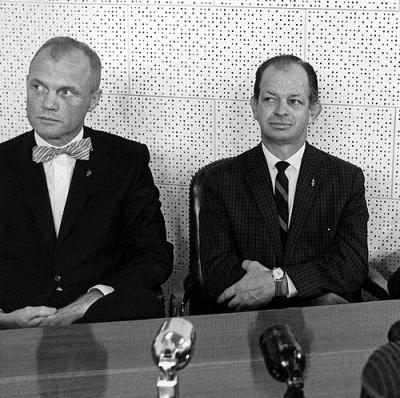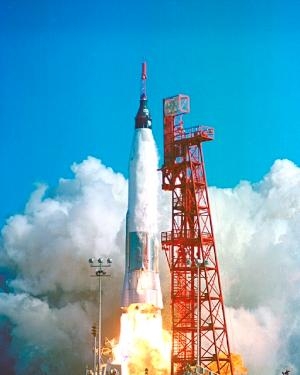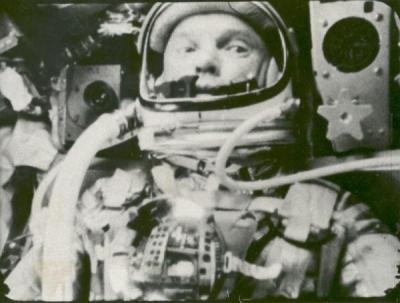God Speed John Glenn
Part 2 of 2 By Wes Oleszewski
John Glenn's mission to become the first American to orbit the
Earth suffered an agonizing amount of delays. Initially planned to
launch in the second week of January 1962, Glenn’s MA-6
launch vehicle had suffered a fuel tank issue. Thus, a new launch
date of January 23 had to be set. On that Tuesday morning
everything was ready, an estimated 600 newsman had gathered at Cape
Canaveral and around the world recovery and tracking stations were
ready to go. The weather however consisted of heavy cloud cover and
some developing thunderstorms. For the second time the launch of
Friendship 7 was scrubbed. The ill weather persisted for the
remainder of the week. Meteorologists at the Cape forecast that
Saturday, 27 January may provide good launch conditions. Once again
John Glenn was suited up loaded aboard his Friendship 7 capsule and
prepared for his launch. For little more than five hours he waited
as the count went down to the T-29 minute mark where it was once
again scrubbed due to weather. Mercury operations director Walt
Williams expressed relief that the launch been scrubbed because of
the weather- saying that "… Nothing was wrong, but nothing
was right either."
Glenn Boards Friendship 7
Spacecraft

In the process of de-fueling and inspecting the MA-6 booster
following the scrub, technicians discovered a leak in the kerosene
propellant tank. Repair of the leak would require a removal and
reinstallation of the insulation around the liquid oxygen tank and
the estimated delay would push the launch back to at least February
13. That date was subsequently pushed back to February 16 when
again the launch would be scrubbed because of bad weather. Finally
the weather conditions appeared favorable for launch on February
20, 1962. It was a date that John Glenn and Friendship 7 could
finally keep.
Launches of this era were far different than the launches that
we came to know in the Space Shuttle era. No one outside of the
technicians and managers working in the block house heard any live
communication during the countdown. Every shred of information that
came from the flight was filtered to and through NASA's project
Mercury public information officer, John “Shorty”
Powers. He was the single source point for flight information to
get to, not only the news media, but the entire world. Although
long-range cameras showed the launch it was NASA's policy that the
only thing about the launch that would be heard would come through
Shorty Powers. He was the censor who decided what information was
appropriate and what was not. So, although thousands of spectators
gathered around the perimeter of Cape Canaveral they didn't hear
the actual countdown- instead they heard Shorty Powers count
backward to the launch. In fact live conversation between the
spacecraft and the ground was not heard directly by the public
until Apollo 10. Likewise live communication in-flight was not
heard by the public until Gemini 4 in 1965 and live television of
spacecraft recovery wasn't provided until the Gemini 7/6 missions
later that same year. So it was that on the morning of the
Friendship 7 launch- everyone simply hung on every word spoken by
Shorty Powers.
John Glenn With Shorty Powers

Awakened at 2:20 AM John Glenn proceeded through the now
traditional steps of breakfast, medical exam, suit up and walk out.
At 5:16 AM he arrived at launch Complex 14 on board the
“transfer van” which was actually was a semi.
tractor-trailor truck. As the count entered a scheduled 90 min.
hold, technicians at the pad found a fault and the booster's
guidance system. For a moment it seemed as if another scrubbed
launch may be in the cards. But the problem was solved by the
replacement of a module and the delay in the launch was cut down to
just 45 minutes. Then at 10 minutes after the hour of seven
o'clock, technicians noticed a broken bolt among the 70 bolts that
held the hatch closed. The bolt was ordered replaced and a launch
was slipped by an additional 40 minutes. Finally at 8:05 AM the
count was resumed. Two more delays came up in the count, one at
8:58 AM involving a fuel pump outlet valve and the second at 9:25
AM involving a computer at the Bermuda tracking station. Each of
these issues were rapidly overcome in the count continued.
As the countdown drew into its final seconds, Mercury astronaut
Scott Carpenter could be heard on the voice loop saying "God speed
John Glenn." For Carpenter it was a brief, localized prayer for the
well-being of his friend and fellow astronaut. If such were to
occur today, however, sadly the person who spoke the words on a
"government" radio would likely end up being sued by an atheist.
Finally just 39 seconds after 9:47 AM count reached zero.
Friendship 7 Liftoff

The ignition sequence for the Atlas-D booster involved the light
off of the two Vernier steering thrusters on the sides of the
vehicle followed less than one second later by the ignition of the
three main engines. Although official documents state that liftoff
occurred "… about T+4 seconds after ignition," examination
of historic video appears to show liftoff initiated around 6.7
seconds after ignition. The precise moment of liftoff was probably
not a large concern aboard Friendship 7 that morning. What John
Glenn was focused upon was following to-the-letter the procedures
that he and his fellow astronauts had written for the launch phase
of the Atlas booster.
He was also well aware of the concerns that many engineers had
about the Atlas booster itself. One such concern was his passing
through the area of maximum aerodynamic pressure on the vehicle, or
“Max-q.” It was the area of boosted flight where the
previous Mercury Atlas, MA-1, had failed. Glenn’s dilemma
being that Max-q and the sound barrier are normally relatively
close to one another along the flight profile. The transonic region
just happens to be an area where the maximum cabin noise and
vibration take place. Dutifully, John Glenn reported that vibration
by saying "… Have some vibration area coming up now." Then
28 seconds later considering what had he just said and decided to
reassure those on the ground, some of whom had their finger on the
command destruct button. "We’re smoothing out some now,
getting out of the vibration area." At 2 minutes and 9, seconds
into powered flight the two outboard booster engines shut down and
were jettisoned. This point in the Atlas’ launch was known as
BECO, or Booster Engine Cutoff. The remaining engine, known as the
sustainer engine, continued to burn for the remainder of powered
flight. Although John Glenn had mistaken some of the plume backflow
from the BECO as being his escape tower jettisoning, some 25
seconds after the booster engines separated he witnessed the actual
automatic jettison of his escape tower. Overall powered flight
lasted for 5 minutes and 1 second.
Every ear in the free world and countless ears behind the Iron
Curtain were glued to their radios as Friendship 7 orbited the
earth. They listened intently as Shorty Powers described flight and
as radio reporters reinterpreted his words. The universal feeling
being that "we" finally have a man up there. And the distinction
became obvious that the difference between the United States flying
an astronaut and the Soviet Union flying a cosmonaut was that NASA
conducted its flights under the glaring scrutiny of the news media
and the full view of the public, while the Soviets conducted their
flights under the shroud of totalitarian secrecy.
Retro Rocket Pack With Straps

Although he had been cleared for "… at least seven
orbits," John Glenn's mission was about to come to an early
conclusion. By the beginning of his second orbit he was dealing
with a persistent problem with a yaw thruster, but a potentially
more dangerous problem was being indicated by the telemetry system.
The "segment 51" sensor was indicating that the capsules landing
bag had deployed. Folded accordion-style between the heat shield in
the capsule’s aft bulkhead, the landing bag was designed to
pop out after reentry and act as both a cushion and the sea anchor
at splashdown. If the indication was valid John Glenn's capsule
would burn up on reentry. A firestorm of phone calls and loop
communications discussing this issue took place following its
initial reception by the Bermuda "TM" controller. Glenn had not
hint of the problem until the 2 hour and 47 second point in the
mission when the Canton Island capcom simply said "We also have no
indication that your landing bag might be deployed. Over." To which
John Glenn replied "Roger. Did someone report landing bag could be
down? Over." The capcom then blew it off by replying with
“Negative we had a request to monitor this and to ask if
you've heard any flapping, when you had high capsule rates…"
John Glenn then went on with his very busy work schedule paying
little mind to the landing bag reference. Meanwhile at Mercury
control the serious debate was being waged between those
controllers who felt that the segment 51 signal was erroneous and
should be ignored and those in NASA management who thought the best
plan of action would be not to jettison the retro rocket package
after retro-fire. The retro rocket package was held on to the heat
shield and the spacecraft by three straps. Management felt that
those straps may hold on just long enough to keep the heat shield
in place.
There are a lot of accounts written by different individuals who
were there at that moment in history when the flight of Friendship
7 appeared to be in jeopardy. There are a lot of documentaries that
have been created about that moment in history as well. Yet no one
specifically says exactly who it was that came up with the idea to
leave the retro package attached. In the largely fictitious movie
posing as a documentary "The Right Stuff" a German rocket scientist
is shown holding a Mercury capsule and discussing the options. Just
for the sake of reality and considering how steeped most of us are
in pop culture, it is important to note that aside from a few
launch pad operations there were largely no German rocket
scientists involved with the Mercury capsule. In fact, the one
individual leading the charge for the retro packet solution was the
developer of the Mercury capsule Max Faget (pronounced Fa-jay). An
original member of the Space Task Group, he carried tremendous
weight in the Mercury Program. According to Gene
Kranz’s terrific book “Failure Is not An
Option” reentry with the retro package remaining attached to
Glenn’s capsule was Max’s idea.
John Glenn In Orbit

On the third orbit Friendship 7 came into ground contact with
the Hawaii station at the 4 hour in 21 minute mark of the mission.
Just 1 minute and 45 seconds later the capcom informed John Glenn
of the full nature of their concern. "Friendship seven, we have
been reading in indication on the ground of segment 51, which is
landing bag deployed. We suspect this is an erroneous signal.
However, Cape would like you to check this by putting the landing
bag switch in auto position, and see if you get a light. Do you
concur with this? Over." The capcom transmitted. Glenn replied,
"Okay. If that's what they recommend, will go ahead and try it. Are
you ready for now?" and from that point on John Glenn was actually
brought into the loop concerning the problem the ground controllers
had been studying for more than an hour and a half. Dutifully Glenn
move switch into the auto position. He then reported "negative, in
automatic position did not get a light and I'm back in the off
position now. Over."
No one really knew for certain whether Friendship 7 would
survive reentry. And although contemporary documentaries and movies
may depict an agonizing length of time that John Glenn had to
contemplate the problem, in fact, just 20 minutes and 5 seconds
separated his notification by ground controllers and reentry
blackout. At 04:42:50 into the flight Friendship 7 began entry
interface. Against the judgment of flight controllers, NASA
management had elected to use and untested procedure based only on
the segment 51 indication and ordered the retro package to be left
on Friendship 7’s heat shield. It was their hope that the
landing bag would remain attached through the majority of the 4
minute reentry. In fact, from Glenn’s real-time reports, the
retro pack remained attached for just the first 24 seconds of the
reentry.
Following the reentry Friendship 7 simply dropped through the
atmosphere for little more than 70,000 feet. It was kept stable
during that time by the constant firing of the reaction control
system jets. Finally at an altitude of 30,000 feet the drogue chute
automatically deployed. This small parachute was designed to
stabilize the capsule as it descended into the thicker atmosphere.
The final step in the parachute sequence came passing through
11,000 feet with the release of the main parachute. Glenn reported
"Chute is out, in reefed condition at 10,800 feet," and then
exclaimed gleefully, "and beautiful chute!" Exactly 12 seconds
after deployment of the main parachute the landing bag that had
causes so much worry prior to reentry deployed normally. For the
next 5 minutes and 10 seconds Friendship 7 floated gracefully the
surface of the Atlantic Ocean where it splashed down and was later
safely recovered by the Navy destroyer USS Noa.
Euphoria across the free world immediately followed John Glenn's
Friendship 7 flight. Americans had the real feeling that they were
finally gaining momentum in the space race with Soviet Union.
Although the Soviets were actually well ahead in flight duration
and in lifting capability NASA sought to trump that advantage with
the fact that the United States launched their rockets in the full
site of the public while Russian flights were conducted in secret.
Of course, John Glenn's flight was censored to a degree. The
landing bag issue, which could have ended Glenn's life, was not
disclosed until after the flight. By then, of course, euphoria of a
successful mission completely overshadowed that little problem. In
fact the fix for the landing bag was quite simple. The heat shield
deployment limit switches which, indicated that the heat shield was
released, were rewired in series rather than parallel and rigged
farther away from the actuation points. The landing bag anomaly
never reappeared on future Mercury flights.

Today, a half-century after the flight of Friendship 7 we
remember and still celebrate John Glenn's successful mission. The
Friendship 7 flight moved people, it moved a nation and it moved
the free world. It silenced congressional critics of NASA and it
gave President John F. Kennedy a shining success in his effort to
reach the moon. Nearly every kid in the United States knew who John
Glenn was, what he had done and what project Mercury was. It had
been demonstrated that the United States could indeed put a man
into orbit and bring them back alive. We had spacecraft, we had the
booster, we had the infrastructure, we had the manpower, we had the
NASA leadership and we had the national will to do the job. That is
in stark contrast to what we have in the United States today as the
United States appears to have none of that at this moment. Perhaps
in looking back once again at John Glenn's Friendship 7 flight we
may consider recapturing what we had on February 20, 1962. It was
an era when no one dared to say that the United States could
“Lead from behind.” (Images provided by NASA)
 ANN's Daily Aero-Term (04.14.24): Maximum Authorized Altitude
ANN's Daily Aero-Term (04.14.24): Maximum Authorized Altitude ANN's Daily Aero-Linx (04.14.24)
ANN's Daily Aero-Linx (04.14.24) Classic Aero-TV: 'We're Surviving'-- Kyle Franklin Describes Airshow Life 2013
Classic Aero-TV: 'We're Surviving'-- Kyle Franklin Describes Airshow Life 2013 Aero-News: Quote of the Day (04.14.24)
Aero-News: Quote of the Day (04.14.24) Airborne 04.09.24: SnF24!, Piper-DeltaHawk!, Fisher Update, Junkers
Airborne 04.09.24: SnF24!, Piper-DeltaHawk!, Fisher Update, Junkers








